TWiki> Main Web>TWikiUsers>OtmanCHARAF>CommentsDarkPhotonsFourLeptons (2018-10-23, OtmanCHARAF)
Main Web>TWikiUsers>OtmanCHARAF>CommentsDarkPhotonsFourLeptons (2018-10-23, OtmanCHARAF) EditAttachPDF
EditAttachPDF
-- OtmanCHARAF - 2018-07-17
The dark photon decay lengths are extracted from the paper
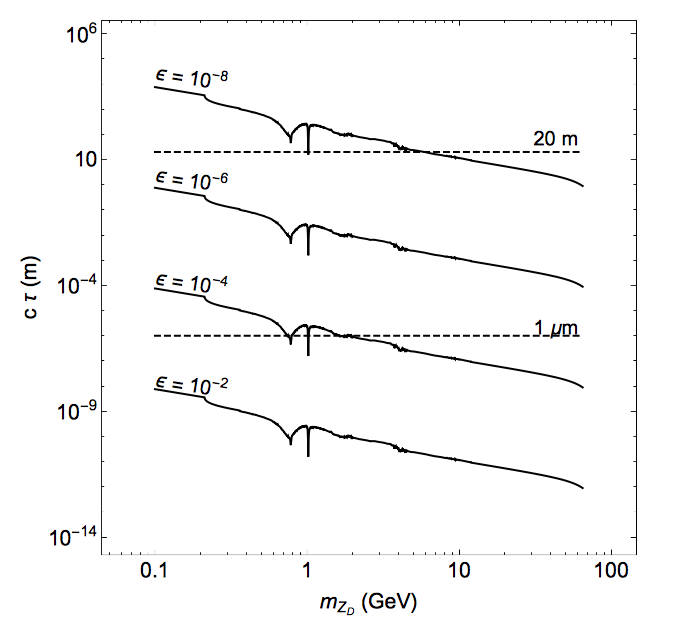 - slide 6: What about other decays of Z_D? Z_D is allowed to decay into anything other than ttbar pairs, democratically. please state this
A statement will be put in the AN about that.
- slide 7: please consider to use looser ID/isolation. adish: have a look at the IDs used in H->4leptons, where they use very loose isolation
I have moved to loose WP for identification and isolation, for muons and electrons. Data/MC efficiency scale factors have been updated accordingly.
- slide 7: Why no SIP3D cut on electrons? Cut based WP doesn't have any dxy dz cuts.
I have added a cut on SIP3D on electrons at 10, just like for muons.
- slide 9: consider checking an algo based on deltaPhi: if the higgs is produced at rest, having S=0 there should be spin correlations in the four leptons. in particular the two negative muons should go in the same direction. same with the positive ones
- slide 11: it was checked that algo5 also holds for different masses.
The following two plots show the algorithm performance for 2016 and 2017 on the left and right respectively.
- slide 6: What about other decays of Z_D? Z_D is allowed to decay into anything other than ttbar pairs, democratically. please state this
A statement will be put in the AN about that.
- slide 7: please consider to use looser ID/isolation. adish: have a look at the IDs used in H->4leptons, where they use very loose isolation
I have moved to loose WP for identification and isolation, for muons and electrons. Data/MC efficiency scale factors have been updated accordingly.
- slide 7: Why no SIP3D cut on electrons? Cut based WP doesn't have any dxy dz cuts.
I have added a cut on SIP3D on electrons at 10, just like for muons.
- slide 9: consider checking an algo based on deltaPhi: if the higgs is produced at rest, having S=0 there should be spin correlations in the four leptons. in particular the two negative muons should go in the same direction. same with the positive ones
- slide 11: it was checked that algo5 also holds for different masses.
The following two plots show the algorithm performance for 2016 and 2017 on the left and right respectively.
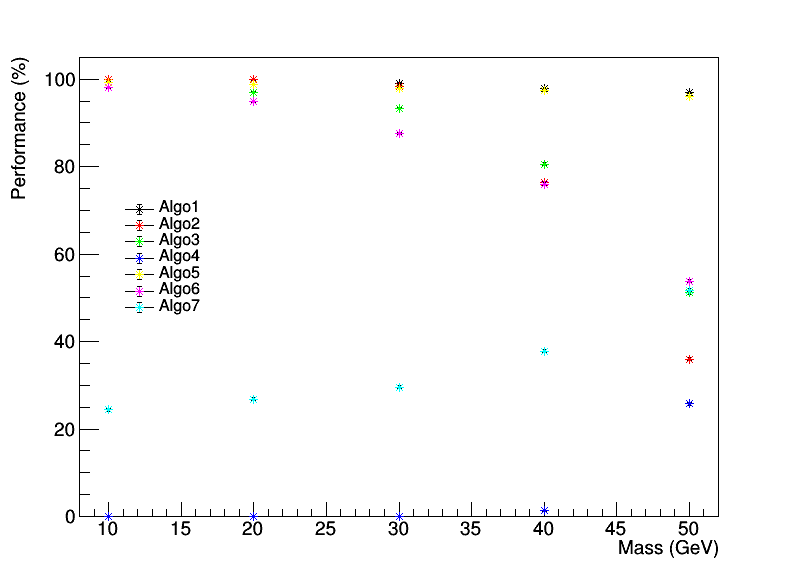
 Algo 6 is an algorithm pairing based on the delta phi between the two pairs being closest to PI.
Algo 7 is an algorithm pairing based on taking the two pairs having the smallest delta phi between the leptons in each pair.
- slide 21: consider looking into angular selections instead of selections based on pt, because the latter could be correlated with mass (which is the final signal extraction variable, so you dont want to shape it artificially). again: phi/deltaPhi could be the most discriminating one, as you are looking at the decay of a scalar. (if you dont want to look at all the 5 angles that are used in the H->ZZ analysis)
The following plots show the delta phi between the two leptons for pair1 and pair2, for signal and total background.
Algo 6 is an algorithm pairing based on the delta phi between the two pairs being closest to PI.
Algo 7 is an algorithm pairing based on taking the two pairs having the smallest delta phi between the leptons in each pair.
- slide 21: consider looking into angular selections instead of selections based on pt, because the latter could be correlated with mass (which is the final signal extraction variable, so you dont want to shape it artificially). again: phi/deltaPhi could be the most discriminating one, as you are looking at the decay of a scalar. (if you dont want to look at all the 5 angles that are used in the H->ZZ analysis)
The following plots show the delta phi between the two leptons for pair1 and pair2, for signal and total background.

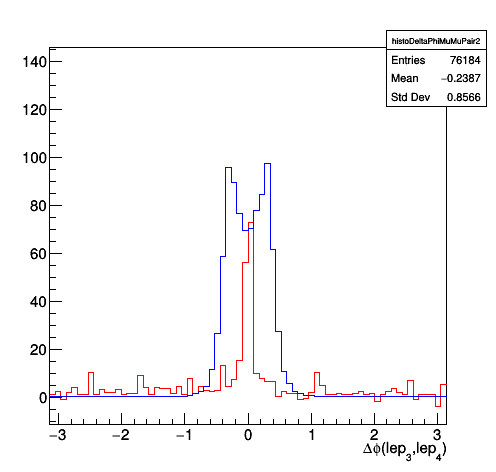 The following two plots show the pt/M as a function of M for each dilepton system.
This clearly shows that there is no correlation between the two variables. A cut on pt/M does not distort the dilepton system mass shape.
The following two plots show the pt/M as a function of M for each dilepton system.
This clearly shows that there is no correlation between the two variables. A cut on pt/M does not distort the dilepton system mass shape.

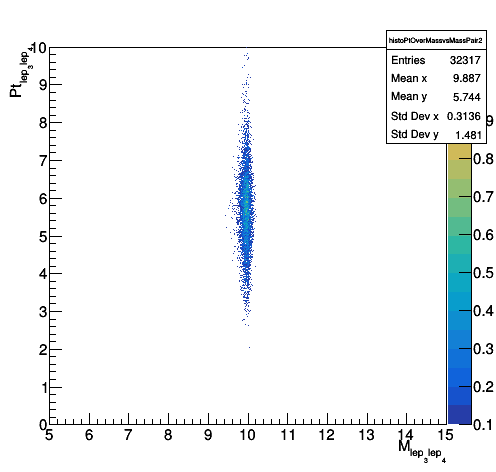 - slide 21: First pair mass > second pair mass (by construction/definition)
Yes, mass(pair1) > mass(pair2)
- slide 23: why are you not selecting on the M(4L), requiring them to be compatible with the MH? please investigate it
The following plot shows the invariant mass of the four lepton system for the signal for the very final event selection.
One clearly sees that the mass M(4L) is already constrained in the range 120-130 GeV.
- slide 21: First pair mass > second pair mass (by construction/definition)
Yes, mass(pair1) > mass(pair2)
- slide 23: why are you not selecting on the M(4L), requiring them to be compatible with the MH? please investigate it
The following plot shows the invariant mass of the four lepton system for the signal for the very final event selection.
One clearly sees that the mass M(4L) is already constrained in the range 120-130 GeV.
 - slide 24: please make the blue histogram stacked and separated in all the different contributions. also: please state what values of epsilon these signal yields refer to. answer: epsilon = 10^-4. adish: would like to know if this isn't already in the long-lived regime
The following two plots give the distributions of pT/M for pairs 1 and 2, just before the pt/M cut. The signal distribution is superimposed with the stacked background contributions. It is clear from there that the major contribution at that point is Drell-Yan. Those values of epsilon are not in the long-lived regime. See plot up.
- slide 24: please make the blue histogram stacked and separated in all the different contributions. also: please state what values of epsilon these signal yields refer to. answer: epsilon = 10^-4. adish: would like to know if this isn't already in the long-lived regime
The following two plots give the distributions of pT/M for pairs 1 and 2, just before the pt/M cut. The signal distribution is superimposed with the stacked background contributions. It is clear from there that the major contribution at that point is Drell-Yan. Those values of epsilon are not in the long-lived regime. See plot up.
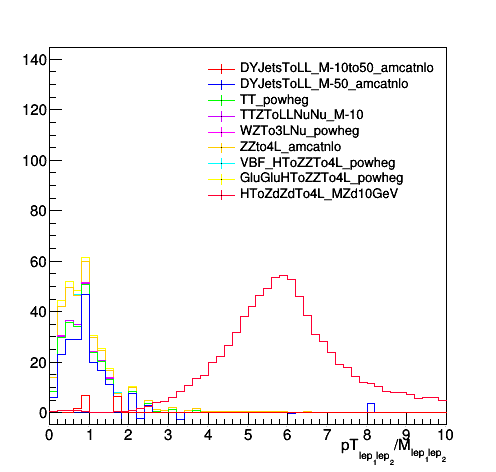
 - slide 25: there doesn't seem a reason to doubt that the simulation describes the algo efficiency wrong, so it was agreed to remove this algo systematic
Systematic has been removed from the data cards for the combine algorithm. However, one still needs to check that the algorithm behaves the same in mc and in data. There is no reason to expect otherwise.
- slide 27: please use the latest/greatest for the Higgs cross sections (from the H xsec WG) and also for the ZZ background. there are much finer cross sections and uncertainties out there, we should use them
I'm using 1.212 pb and 1.325 pb for the ZZ background.
For the gg Higgs, I'm using 12.12 fb, both for 2016 and 2017.
For the VBF Higgs, I'm using 1 fb, both for 2016 and 2017.
This is close to the values used in AN2017_342_v10
- slide 29: replace "yields" with "signal" (with given epsilon assumption)
Replaced.
- slide 29: Impact of resolution? Do we need a larger window?
Not yet done.
- slide 30: please compare only the 4mu channel to atlas
- atlas is looking at H-> Z ZD (not only ZDZD). would be nice to add this to the paper, it would really bring a lot to the analysis. you could revise the pairing algorithm, but that would be the only thing to adjust and it's not a huge amount of work. but would add a lot to the scope (ZDZD corresponds to Epsilon<
- slide 25: there doesn't seem a reason to doubt that the simulation describes the algo efficiency wrong, so it was agreed to remove this algo systematic
Systematic has been removed from the data cards for the combine algorithm. However, one still needs to check that the algorithm behaves the same in mc and in data. There is no reason to expect otherwise.
- slide 27: please use the latest/greatest for the Higgs cross sections (from the H xsec WG) and also for the ZZ background. there are much finer cross sections and uncertainties out there, we should use them
I'm using 1.212 pb and 1.325 pb for the ZZ background.
For the gg Higgs, I'm using 12.12 fb, both for 2016 and 2017.
For the VBF Higgs, I'm using 1 fb, both for 2016 and 2017.
This is close to the values used in AN2017_342_v10
- slide 29: replace "yields" with "signal" (with given epsilon assumption)
Replaced.
- slide 29: Impact of resolution? Do we need a larger window?
Not yet done.
- slide 30: please compare only the 4mu channel to atlas
- atlas is looking at H-> Z ZD (not only ZDZD). would be nice to add this to the paper, it would really bring a lot to the analysis. you could revise the pairing algorithm, but that would be the only thing to adjust and it's not a huge amount of work. but would add a lot to the scope (ZDZD corresponds to Epsilon<>Kappa)
Sample production is being made.
Comments raised before preapproval
Comments raised during March 28th meeting
- IMPORTANT: please talk to HIG-18-003 because it's a search for the same H->ZDZD signal. but they are probably also sensitive to the other signal also because they look at the two dimuon masses separately. also check with the dark photon to dimuon group (adish and pier). Additionally EXO-18-008 and HIG-16-041 could be relevant. HIG-18-003 is a search for dark photons in the low mass regime, i.e. 0.25 to 8.25 GeV. - intro: please add feynman graphs. it's t-channel with b propagator in the center The FCNC interpretation has been dropped. - Z_D width in slide 4 is unreasonably tight, width seen in slide 5 is more reasonable - slide 7: typo, it's feb3 miniAOD Typo corrected. - slide 8: please switch to IsoMu24, or drop it (double mu and triple mu should do the job) Dropped single lepton triggers. Keeping only double and triple lepton triggers. - slide 10: 0.2 seems like a large cone. consider using a smaller cone Cones used are 0.02 and 0.2 for muons and electrons respectively. - slide 13: muon experts (raffaella) will check about low-pt scale factors. also, should switch to lumi-weighted SF average as opposed to throwing a random number. Still missing some low pt scale factors for muons and recommended systematic uncertainties related to electron SFs. Lumi weighted average is in place and used. - slide 15: increase the x axis numbers, they are unreadable. Done. - unblinding? this should be preselection so not possible to see signal. The cut flow histograms clearly demonstrate that, at this stage of the selection, a signal is completely drowned in the total background. - slide 20: please have a clear definition of M1 and M2, example: take M1 as largest, M2 as smallest Done. For all pairs, the convention is that M1 > M2 always. - on PDF systematics: if you generate your own signal privately you should first of all present in the MC&interpretations group to have it validated, and you should also be able to generate the weights. please check with the MC&interpretations group, and with the other groups (see above) as they should already have advanced tools The PDF syst problem is solved. The HAHM model is particular in the sense that it contains non massless b quarks, constraining the MG production to the 4F scheme. The default PDF used corresponded to the 5F scheme and therefore, pdf weights were not included. I switched to the 4F PDF sets. - do you have any paper to be able to reference to see if your FCNC model explains the b anomalies. please make sure you have it backed up by a theory paper The FCNC interpretation has been dropped due to lack of models for sbX vertices. - there is no reason not to add 2017 data. please add it. Added 2017 data and extended to 4L channels.Comments raised during July 04th meeting
- looks like the analysis is done only down to M(ZD)=10 GeV. why not go to lower? please explore possibility. adish supports this and mentions that ATLAS goes down to 1 GeV. - slide 6: Epsilon- Kappa values vs cross-section and lifetime info is needed to assess relevant phase space. The cross sections are summarized in the following tables. These are for values of epsilon and kappa equal to 1e-4 and 1e-2 respectively.| Mass | 10 GeV | 20 GeV | 30 GeV | 40 GeV | 50 GeV |
|---|---|---|---|---|---|
| 2016 | 70.33 | 55.07 | 42.73 | 30.52 | 19.18 |
| 2017 | 64.02 | 50.20 | 39.12 | 27.99 | 17.57 |
 - slide 6: What about other decays of Z_D? Z_D is allowed to decay into anything other than ttbar pairs, democratically. please state this
A statement will be put in the AN about that.
- slide 7: please consider to use looser ID/isolation. adish: have a look at the IDs used in H->4leptons, where they use very loose isolation
I have moved to loose WP for identification and isolation, for muons and electrons. Data/MC efficiency scale factors have been updated accordingly.
- slide 7: Why no SIP3D cut on electrons? Cut based WP doesn't have any dxy dz cuts.
I have added a cut on SIP3D on electrons at 10, just like for muons.
- slide 9: consider checking an algo based on deltaPhi: if the higgs is produced at rest, having S=0 there should be spin correlations in the four leptons. in particular the two negative muons should go in the same direction. same with the positive ones
- slide 11: it was checked that algo5 also holds for different masses.
The following two plots show the algorithm performance for 2016 and 2017 on the left and right respectively.
- slide 6: What about other decays of Z_D? Z_D is allowed to decay into anything other than ttbar pairs, democratically. please state this
A statement will be put in the AN about that.
- slide 7: please consider to use looser ID/isolation. adish: have a look at the IDs used in H->4leptons, where they use very loose isolation
I have moved to loose WP for identification and isolation, for muons and electrons. Data/MC efficiency scale factors have been updated accordingly.
- slide 7: Why no SIP3D cut on electrons? Cut based WP doesn't have any dxy dz cuts.
I have added a cut on SIP3D on electrons at 10, just like for muons.
- slide 9: consider checking an algo based on deltaPhi: if the higgs is produced at rest, having S=0 there should be spin correlations in the four leptons. in particular the two negative muons should go in the same direction. same with the positive ones
- slide 11: it was checked that algo5 also holds for different masses.
The following two plots show the algorithm performance for 2016 and 2017 on the left and right respectively.

 Algo 6 is an algorithm pairing based on the delta phi between the two pairs being closest to PI.
Algo 7 is an algorithm pairing based on taking the two pairs having the smallest delta phi between the leptons in each pair.
- slide 21: consider looking into angular selections instead of selections based on pt, because the latter could be correlated with mass (which is the final signal extraction variable, so you dont want to shape it artificially). again: phi/deltaPhi could be the most discriminating one, as you are looking at the decay of a scalar. (if you dont want to look at all the 5 angles that are used in the H->ZZ analysis)
The following plots show the delta phi between the two leptons for pair1 and pair2, for signal and total background.
Algo 6 is an algorithm pairing based on the delta phi between the two pairs being closest to PI.
Algo 7 is an algorithm pairing based on taking the two pairs having the smallest delta phi between the leptons in each pair.
- slide 21: consider looking into angular selections instead of selections based on pt, because the latter could be correlated with mass (which is the final signal extraction variable, so you dont want to shape it artificially). again: phi/deltaPhi could be the most discriminating one, as you are looking at the decay of a scalar. (if you dont want to look at all the 5 angles that are used in the H->ZZ analysis)
The following plots show the delta phi between the two leptons for pair1 and pair2, for signal and total background.

 The following two plots show the pt/M as a function of M for each dilepton system.
This clearly shows that there is no correlation between the two variables. A cut on pt/M does not distort the dilepton system mass shape.
The following two plots show the pt/M as a function of M for each dilepton system.
This clearly shows that there is no correlation between the two variables. A cut on pt/M does not distort the dilepton system mass shape.

 - slide 21: First pair mass > second pair mass (by construction/definition)
Yes, mass(pair1) > mass(pair2)
- slide 23: why are you not selecting on the M(4L), requiring them to be compatible with the MH? please investigate it
The following plot shows the invariant mass of the four lepton system for the signal for the very final event selection.
One clearly sees that the mass M(4L) is already constrained in the range 120-130 GeV.
- slide 21: First pair mass > second pair mass (by construction/definition)
Yes, mass(pair1) > mass(pair2)
- slide 23: why are you not selecting on the M(4L), requiring them to be compatible with the MH? please investigate it
The following plot shows the invariant mass of the four lepton system for the signal for the very final event selection.
One clearly sees that the mass M(4L) is already constrained in the range 120-130 GeV.
 - slide 24: please make the blue histogram stacked and separated in all the different contributions. also: please state what values of epsilon these signal yields refer to. answer: epsilon = 10^-4. adish: would like to know if this isn't already in the long-lived regime
The following two plots give the distributions of pT/M for pairs 1 and 2, just before the pt/M cut. The signal distribution is superimposed with the stacked background contributions. It is clear from there that the major contribution at that point is Drell-Yan. Those values of epsilon are not in the long-lived regime. See plot up.
- slide 24: please make the blue histogram stacked and separated in all the different contributions. also: please state what values of epsilon these signal yields refer to. answer: epsilon = 10^-4. adish: would like to know if this isn't already in the long-lived regime
The following two plots give the distributions of pT/M for pairs 1 and 2, just before the pt/M cut. The signal distribution is superimposed with the stacked background contributions. It is clear from there that the major contribution at that point is Drell-Yan. Those values of epsilon are not in the long-lived regime. See plot up.

 - slide 25: there doesn't seem a reason to doubt that the simulation describes the algo efficiency wrong, so it was agreed to remove this algo systematic
Systematic has been removed from the data cards for the combine algorithm. However, one still needs to check that the algorithm behaves the same in mc and in data. There is no reason to expect otherwise.
- slide 27: please use the latest/greatest for the Higgs cross sections (from the H xsec WG) and also for the ZZ background. there are much finer cross sections and uncertainties out there, we should use them
I'm using 1.212 pb and 1.325 pb for the ZZ background.
For the gg Higgs, I'm using 12.12 fb, both for 2016 and 2017.
For the VBF Higgs, I'm using 1 fb, both for 2016 and 2017.
This is close to the values used in AN2017_342_v10
- slide 29: replace "yields" with "signal" (with given epsilon assumption)
Replaced.
- slide 29: Impact of resolution? Do we need a larger window?
Not yet done.
- slide 30: please compare only the 4mu channel to atlas
- atlas is looking at H-> Z ZD (not only ZDZD). would be nice to add this to the paper, it would really bring a lot to the analysis. you could revise the pairing algorithm, but that would be the only thing to adjust and it's not a huge amount of work. but would add a lot to the scope (ZDZD corresponds to Epsilon<
- slide 25: there doesn't seem a reason to doubt that the simulation describes the algo efficiency wrong, so it was agreed to remove this algo systematic
Systematic has been removed from the data cards for the combine algorithm. However, one still needs to check that the algorithm behaves the same in mc and in data. There is no reason to expect otherwise.
- slide 27: please use the latest/greatest for the Higgs cross sections (from the H xsec WG) and also for the ZZ background. there are much finer cross sections and uncertainties out there, we should use them
I'm using 1.212 pb and 1.325 pb for the ZZ background.
For the gg Higgs, I'm using 12.12 fb, both for 2016 and 2017.
For the VBF Higgs, I'm using 1 fb, both for 2016 and 2017.
This is close to the values used in AN2017_342_v10
- slide 29: replace "yields" with "signal" (with given epsilon assumption)
Replaced.
- slide 29: Impact of resolution? Do we need a larger window?
Not yet done.
- slide 30: please compare only the 4mu channel to atlas
- atlas is looking at H-> Z ZD (not only ZDZD). would be nice to add this to the paper, it would really bring a lot to the analysis. you could revise the pairing algorithm, but that would be the only thing to adjust and it's not a huge amount of work. but would add a lot to the scope (ZDZD corresponds to Epsilon<Comments raised during July 25th meeting
- pg 4: ZD+ZD official signal production request has been made. Please submit the Z+ZD request asap. - pg 5: ZD decays are prompt in the mass regime of interest for Epsilon ~ 10^-4. However this might need to be revisited when setting limits (i.e. a region of validity wrt epsilon as a function of mass). - pg 8: What is the gain in signal efficiency & limit due to relaxed lepton IDs? Please check. - pg 9: Why reject events with 5+ leptons? We suggest to keep 5+ lepton events but only look at first 4 leptons for analysis considerations. This should make sure the analysis structure stays otherwise unchanged. - pg 11-13: New algos 6, 7 are added as per our suggestions from last time, but are not very performant wrt algo 5. - pg 39: Some listed muon triggers are prescaled, please check with Benjamin for the correct list (add DZ versions of HLT paths as recommended by Muon POG). - pg 16-21: These use the preselection cuts (just 4 leptons and pt cuts, no min mass veto on pairs, i.e. quarkonia are included). - pg 16-21: Please improve style of plots: modify histogram style such that individual stacks are easily recognisable (the "no-fill" option makes this very difficult during meetings and in B&W print), optimize against over-binning such that individual contributions are largely continuous, modify legend box such that text is readable with appropriate labels, reduce ratio panel y-range to "-1"-to-"1" such that 10%s level disagreements are visible, etc. - pg 16-21: Excess at low mass is said to be due to quarkonia contributions. Please provide revised preselection plots with explicit pair mass veto to reject such contributions not modelled in MC. These are effectively cut-out in the analysis anyway. - pg 26: Please zoom in on x-axis, optimize axis ranges and binning such that any structures are visible. - pg 27: Is Dphi cut useful perhaps after the pt/M cut? Please check. - pg 29: Why not apply a "Higgs mass window" cut? The claim is that cutting on 2 pairs of ZD candidates (with windows 3 times the signal width) not only reduces the background to zero, but also focuses on Higgs mass anyway. The latter is not obvious to us (for backgrounds). Please provide the signal and background 4-lepton mass distribution after individual ZD cuts (perhaps also with relaxed larger windows as well to recover some statistics). It is possible that the bulk of currently remaining background that pass the individual ZD cuts on the pairs actually come from a 4-lepton mass region inconsistent with Higgs decays. Such a Higgs mass window cut might be even more necessary if you consider Z+ZD scenario, where one lepton pair will have to be on-Z and much more ZZ* background will contribute. - pg 33: "Raw" background yields are <10 mostly. So most dominant uncertainty is statistical. We need to verify that MC estimation of backgrounds are "smooth" enough, and that fakes are indeed negligible. Please provide looser signal selection plots to show the composition of the remaining background (perhaps a selection with 4+ leptons, where both (or one of the) pairs have masses between 10 and 60 GeV? Then we can inspect the individual pair mass distributions. - pg 35-36 : Some unhealthy limit behaviours (jumps etc) are due to limit jobs thats failed to converge. These will be resubmitted. - General: Why stop at 10 GeV when ATLAS is going all the way to 1 GeV? Some lower mass signal is being produced but probably won't get added to the analysis if it necessitates significant changes in the analysis strategy. We are already doing better than ATLAS esp. since we are doing a 2016+17 combination.Topic revision: r3 - 2018-10-23 - OtmanCHARAF
Webs
- ABATBEA
- ACPP
- ADCgroup
- AEGIS
- AfricaMap
- AgileInfrastructure
- ALICE
- AliceEbyE
- AliceSPD
- AliceSSD
- AliceTOF
- AliFemto
- ALPHA
- Altair
- ArdaGrid
- ASACUSA
- AthenaFCalTBAna
- Atlas
- AtlasLBNL
- AXIALPET
- CAE
- CALICE
- CDS
- CENF
- CERNSearch
- CLIC
- Cloud
- CloudServices
- CMS
- Controls
- CTA
- CvmFS
- DB
- DefaultWeb
- DESgroup
- DPHEP
- DM-LHC
- DSSGroup
- EGEE
- EgeePtf
- ELFms
- EMI
- ETICS
- FIOgroup
- FlukaTeam
- Frontier
- Gaudi
- GeneratorServices
- GuidesInfo
- HardwareLabs
- HCC
- HEPIX
- ILCBDSColl
- ILCTPC
- IMWG
- Inspire
- IPv6
- IT
- ItCommTeam
- ITCoord
- ITdeptTechForum
- ITDRP
- ITGT
- ITSDC
- LAr
- LCG
- LCGAAWorkbook
- Leade
- LHCAccess
- LHCAtHome
- LHCb
- LHCgas
- LHCONE
- LHCOPN
- LinuxSupport
- Main
- Medipix
- Messaging
- MPGD
- NA49
- NA61
- NA62
- NTOF
- Openlab
- PDBService
- Persistency
- PESgroup
- Plugins
- PSAccess
- PSBUpgrade
- R2Eproject
- RCTF
- RD42
- RFCond12
- RFLowLevel
- ROXIE
- Sandbox
- SocialActivities
- SPI
- SRMDev
- SSM
- Student
- SuperComputing
- Support
- SwfCatalogue
- TMVA
- TOTEM
- TWiki
- UNOSAT
- Virtualization
- VOBox
- WITCH
- XTCA
Welcome Guest Login or Register
or Ideas, requests, problems regarding TWiki? use Discourse or Send feedback


